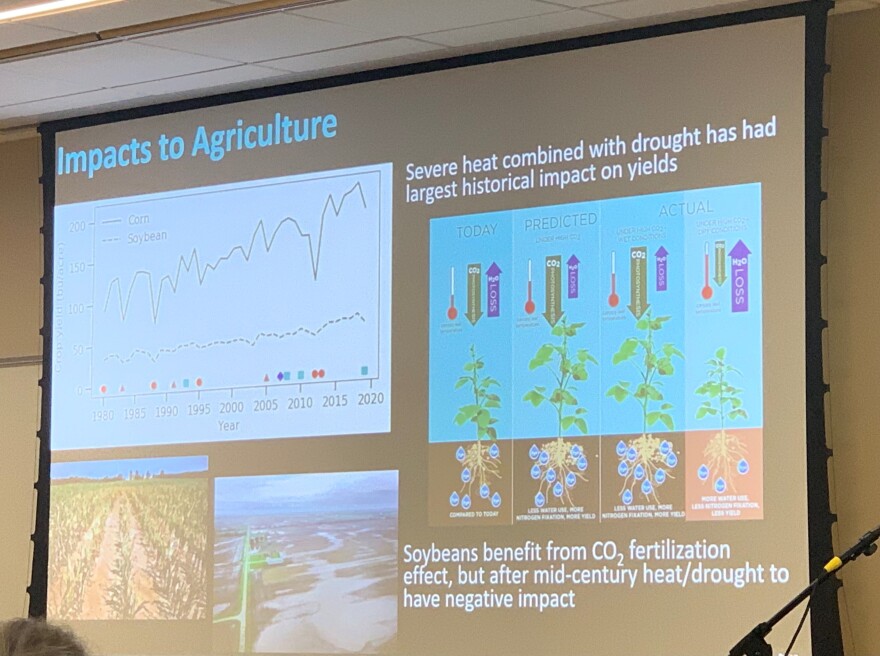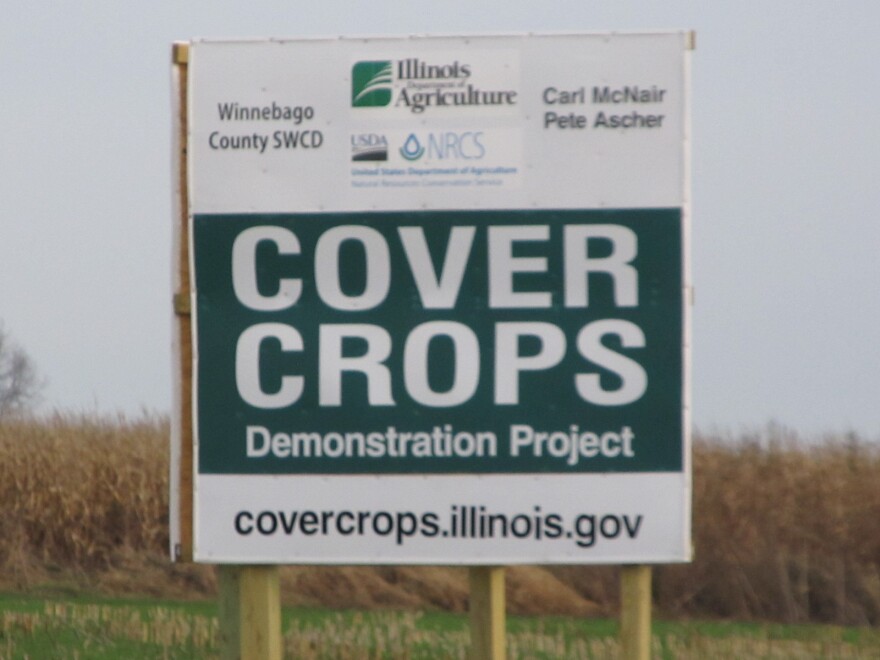Dr. Donald Wuebbles grew up on a farm outside the southern Illinois town of Carlisle.
Now he's one of the nation's leading climate scientists, a professor of atmospheric sciences at University of Illinois and the2015-2017 White House Climate Expert.
He visited Peoria on Friday to deliver the keynote address during Bradley University’s summit on the impacts of climate change on the rural Midwest.
“Some years ago, I developed an analogue for how one looks at climate called ‘the moving states,’” he said. “Illinois looks a little bit more like eastern Texas by the end of the century.”
Watch this story on TikTok: WCBURadio
The last Ice Age saw area temperatures warm by 10 degrees Fahrenheit, a time when central Illinois was covered by ice. In the last 50 years, Illinois temperatures have increased by 1.8 degrees Fahrenheit.
The Midwest is actually warming faster than any other area of the country. In contrast to the rest of America, Wuebbels said temperatures in Illinois, Iowa and Missouri are most rapidly increasing at night.
But like the rest of the country, Wuebbles said hot days are becoming hotter.

Wuebbles said scientists know these trends are tied to a rise in human activity through rising carbon dioxide emissions. But despite this, he scientists and policy makers are still battling basic misinformation around climate change, he said.
“We hear all the time that, ‘Oh, it's just the sun.’ … Actually, the sun has decreased in its output slightly, very, very slightly,” he said. “The other thing we hear all the time, ‘Oh, it's just natural cycles. We're just you know, we're just in one of those cycles. It's gonna come back.’ You know, we have a pretty good understanding of what the Earth's climate system has been like for millions of years. We know there's been past changes in climate, but there's always been a reason for it. Sometimes it is the sun. Sometimes it's because … there was a lot of plant material trapped underground. In the Jurassic era, when large volcanic eruptions released that gas in the atmosphere, and we had high levels of carbon dioxide.
“…You know, current levels of carbon dioxide are about 40% higher than they were the last 3 million years. And then that's been caused largely because we're burning fossil fuels. And so, we know, for a long time, that carbon dioxide has played a very important role in our climate system. And yet, you'll hear all this misinformation.”
Wuebbles urged audience members at Friday's summit to remain positive.
“Maintain a sense of hope," he said. "We can solve this. … we need to protect our home.”
Climate change's impact on Illinois farms
A major takeaway of Wuebbels' presentation was that Illinois' changing climate is and will continue to have a huge impact on agriculture.
The 2019 floods led to $6.2 billion of damage to the economy in the Midwest. The 2012 drought did $3.5 billion in crop losses in Illinois.
Beyond extreme weather, Wuebbles said the overall rise in warm days has invited more pests and diseases to ravage the state's crops and livestock. Invasive species such as the Emerald ash borer and honeysuckle love warmer temperatures.
And a note of caution to allergy sufferers: Wuebbles said pollen counts are increasing to the tune of 15 days or more each year.
Got allergies? Bad news. Dr. Donald Wuebbles says weeds love rising Co2 levels. (Big yikes. I can’t give any more of my money to Flonase.) pic.twitter.com/I17qYCziFa
— Hannah Alani (@hannahalani) November 5, 2021
Climate experts agree that global warming will likely rise to 1.5 degrees Celsius between 2030 and 2052 if warming continues to increase at its current rate. And to significantly slow this down? Society must achieve a 45% drop in emissions by 2050.
Karen Peterson of the Nature Conservancy attended Friday’s summit. She said it is cheaper to confront climate change directly than to pay for the consequences of inaction.
She also said tackling climate change successfully depends on the rapid build out of renewable energy with as minimal disruption to farmers as possible.
“The good news is that the U.S. can meet its renewable energy needs using only low-impact areas,” she said. “In Illinois, we are just initiating the work to understand and address barriers to the development of renewable energy on abandoned mine lands and other brownfields, like landfills. We are also advocating in the policy realm for consistent use of a hierarchy in solar development, so that solar is prioritized first on rooftops, parking lots … rather than prime farmland, or natural areas in the state.”

Adam Nielsen leads the Illinois Farm Bureau. He said farmers are indeed seeing an up-tick in weed growth due to warmer temperatures.
Double digit rainfalls coupled with extreme weather patterns, such as the 2019 Derecho, are a source of angst, as well.
“Climate, always an issue for us in agriculture,” he said. “You have to deal with it, no matter if it's good or bad. You know, the growing season is changing. There's no question. We have already seen extreme weather events. The 10-inch rain that went through Central Illinois, it happened to wipe out one of our farmers market growers here in the Bloomington-Normal area.”
Nielsen said he's proud of Illinois farmers for embracing renewable energy. Illinois is the country's third highest producer of ethanol. Many farmers have put windmills and solar panels on their land, too.
“The Trump administration just wasn't really interested in climate policy,” he said. “During that period of time, we added climate change policy to our policy book. We pushed to get it included at the national level, so our affiliated American Farm Bureau now has climate policy that came from the state of Illinois.”

Farm land makes up half of Illinois. Peterson said farmers have a role to play in helping meet climate change goals.
In addition to putting renewable energy on their farms, there’s other things farmers can do, she said.
“In Illinois, the biggest low-cost opportunities to reduce emissions through natural and working lands are both in the agricultural sector,” she said. “Two options rise to the top: the use of cover crops on agricultural fields, and cropland nutrient management, which is really referring to practices to reduce fertilizer use. And uptake of these practices is currently very low. As of 2018, I think only around 3.5 percent of Illinois fields used cover crops. … So there's a huge opportunity for expansion.”
Learn More: Illinois officials release 2021 Nutrient Loss Reduction Strategy Biennial Report

Of the 435 Congressional districts, U.S. Rep. Darin LaHood – a Republican from Dunlap – said his 18th Congressional District is the nation's 8th-largest producer of corn and soybeans. And, about 94 percent of the world's pumpkins come from his district.
“In dealing with farmers and ag families throughout my district, I have found that farmers are … some of the most engaged when it comes to conservation, being really good stewards of the land, and looking out for the best interests of the climate,” he said. “I'm really proud … my district that I represent is one of the largest wind producing districts in the country. And I've been a supporter of helping our wind energy industry, with tax credits and tax incentives and working on the Ways and Means Committee.”
Policymakers: Rural America must have a 'seat at the table'
During his remarks on Friday, LaHood credited the private sector with leading the way on climate-friendly innovation and production, noting that electric truck manufacturer Rivian in his district.
He said he test drove a truck six weeks ago, and that the company will have 4,000 workers in one year. Contracts with delivery giant Amazon are on the horizon, too, LaHood said.
“The government has helped with a lot of things but it’s the private sector leading the way there.”

LaHood is a member of the Conservative Climate Caucus in Congress and is running for re-election.
Following Bradley’s climate summit, the House of Representatives passed a historic $1 trillion federal infrastructure bill, the largest investment in climate change solutions in the history of the U.S. LaHood voted against the bill.
Darin LaHood votes against $1 trillion bipartisan infrastructure bill
Peoria's other representative in Congress is Cheri Bustos – a Democrat from Moline. She also joined Friday's summit. Bustos represents the Illinois 17th district and is not running for re-election. She voted for the infrastructure bill.
Bustos said she sees climate change as the most pressing issue of her time.
“The way I look at this is that, in rural America, I think there's been a lot of fingers pointed at us,” she said. “Nobody wants to be talked down to, nobody wants to be blamed. We want to be part of the solution. I wrote something in the last congressional session called the Rural Green Partnership. … a framework of policies and principles that seek to address this looming crisis by giving our rural communities and industries around us a seat at the climate change table.”
Illinois State Sen.Dave Koehler (D-Peoria) says government action does make a difference.
This year the state passed the Clean Energy Jobs Act, which mandates all carbon emission-producing industries — such as the Powerton Plant in Pekin — are mandated to close within the next 50 years. The bill also mandates requirements to partner with community-based organizations on workforce training to ensure equity and "head of household jobs" in the new green industries.
“The good news, as I reflect back on where we've been with this whole discussion, is that several years ago, we were arguing about whether climate change is real or not. Is anybody have any doubts about that still?” he said. “So now we're talking about how we actually deal with climate change.
“…I think Illinois is postured to do this and do it well. We passed in addition to the Clean Energy Jobs Act, a bill just this last couple of weeks, called the Reimagining Electric Vehicles bill. So, we are now incentivizing developing Illinois as the electric vehicle hub of the United States, and of the world.”
Q&A: Here's How The Illinois Energy Bill Will Affect The Peoria Area
Koehler noted that Illinois is the nation's top user of nuclear energy. The state's 11 plants produce about half the state's energy, he said.
"It’s controversial, but so was solar," he said.


